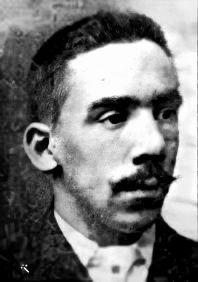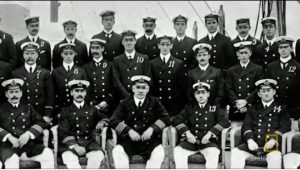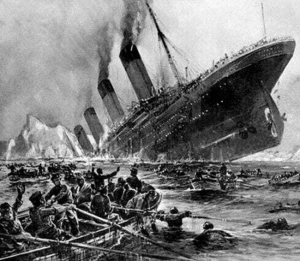 Charles Joughin had to figure that he was one of the most fortunate people on earth in 1912. Joughin was a British-American chef who had just landed a job as the chief baker on the greatest ship there was at the time…Titanic. Charles Joughin was born on Patten Street, next to the West Float in Birkenhead, England, on August 3, 1878. His parents were John Edwin (1846–1886)…a licensed victualer (a British person who is licensed to sell alcoholic liquor), and Ellen (Crombleholme) Joughin (1850–1938). He was enamored with the sea his whole young life, and he first went to sea in 1889 at age 11. He went on to become chief baker on various White Star Line steamships, notably the RMS Olympic, Titanic’s sister ship.
Charles Joughin had to figure that he was one of the most fortunate people on earth in 1912. Joughin was a British-American chef who had just landed a job as the chief baker on the greatest ship there was at the time…Titanic. Charles Joughin was born on Patten Street, next to the West Float in Birkenhead, England, on August 3, 1878. His parents were John Edwin (1846–1886)…a licensed victualer (a British person who is licensed to sell alcoholic liquor), and Ellen (Crombleholme) Joughin (1850–1938). He was enamored with the sea his whole young life, and he first went to sea in 1889 at age 11. He went on to become chief baker on various White Star Line steamships, notably the RMS Olympic, Titanic’s sister ship.
Joughin married Louise Woodward (born 11 July 1879), a native of Douglas, Isle of Man, on November 17, 1906, in Liverpool, England. They had a daughter, Agnes Lillian, in 1907, and a son, Roland Ernest, in 1909. It is believed that Louise died from complications in childbirth around 1919. Their new son, Richard, was also lost. It was a low point in his life.
As we all know, the job Joughin landed on the Titanic was going to prove to be a disaster. When the ship hit an iceberg on the evening of April 14th, at 11:40pm, Joughin was off duty. He was in his bunk when he felt the shock of the collision and immediately got up. He knew that this could not be good. Word was being passed down from the upper decks that officers were getting the lifeboats ready for launching. Joughin sent his thirteen men up to the boat deck with provisions for the lifeboats…four loaves of bread apiece, about forty pounds of bread. Joughin stayed behind for a time, but then followed them, reaching the Boat Deck at around 12:30am, he then helped with the evacuation.
Once on deck, Joughin joined Chief Officer Henry Tingle Wilde by Lifeboat 10. Joughin and the stewards and other seamen began helping the ladies and children through the crowd of people to the lifeboat. Sadly, many of the women were more afraid of the lifeboats than they were the sinking Titanic. They began to run away, saying that they were safer aboard the Titanic than in the tiny boats being tossed in the waves. Leaving him no choice, the Chief Baker then went on to A Deck and forcibly brought up women and children, throwing them into the lifeboat.
Joughin had been assigned as captain of Lifeboat 10, but he did not board the boat, because it was already being crewed by two sailors and a steward. After Lifeboat 10 was launched, Joughin went below, and “had a drop of liqueur” in his quarters, which was in reality a tumbler half-full of whiskey, as he later specified. Joughin was sure that he would not be one of the people allowed onboard a lifeboat, because there were simply not enough lifeboats to hold all the people onboard Titanic. After his drink, Joughin came upstairs again, after meeting “the old doctor,” assumedly William O’Loughlin. This was quite possibly the last time anyone ever saw  O’Loughlin. When Joughin arrived back at the Boat Deck, the rushing for boats had ended, because all the boats had been lowered. He then went down into the A Deck promenade and threw about fifty deck chairs overboard so that they could be used as flotation devices, by the unfortunate ones who could not get into a boat.
O’Loughlin. When Joughin arrived back at the Boat Deck, the rushing for boats had ended, because all the boats had been lowered. He then went down into the A Deck promenade and threw about fifty deck chairs overboard so that they could be used as flotation devices, by the unfortunate ones who could not get into a boat.
Joughin then went into the deck pantry on A Deck, for a drink of water. Suddenly, he heard a loud crash, “as if part of the ship had buckled” and indeed it had. He left the pantry and joined the crowd running aft toward the poop deck. As he was crossing the well deck, the ship suddenly gave a list over to port and, according to him, threw everyone in the well in a pile except for him. Joughin climbed to the starboard side of the poop deck, and hoisted himself over the safety rail, so that he was on the outside of the ship as it went down by the head. As the ship went down in a vertical position at 2:20am on April 15, 1912, Joughin rode it down as if it were an elevator, somehow managing not to get his head under the water. He said his head “may have been wetted, but no more.” So it was that Joughin was the last survivor to leave the Titanic. Now began his real ordeal.
Joughin testified that he kept paddling and treading water for about two hours. He also admitted to hardly feeling the cold, which he credited to the whiskey he drank. When daylight broke, he spotted the upturned Collapsible B lifeboat, with Second Officer Charles Lightoller and around 30 men standing on the side of the boat. Joughin slowly swam towards it, but there was no room for him. Cook Isaac Maynard, recognized him and held his hand as the Chief Baker held onto the side of the boat, with his feet and legs still in the water. A short time later, another lifeboat appeared and Joughin swam to it. He was taken in, where he stayed until he boarded the RMS Carpathia that had come to their rescue. Miraculously, he was rescued from the sea with only swollen feet. He survived the ship’s sinking, becoming notable for having survived in the frigid water for an exceptionally long time before being pulled onto the overturned Collapsible B lifeboat with virtually no ill effects. It is estimated that he was in the water for about four hours.
After surviving the Titanic disaster, Joughin returned to England, and was one of the crew members who reported to testify at the British Wreck Commissioner’s inquiry into the sinking headed by Lord Mersey. In 1920, Joughin moved permanently to the United States to Paterson, New Jersey. According to his obituary he was also on board the SS Oregon when it sank in Boston Harbor in 1886. He also served on American Export  Lines ships and on World War II troop transports before retiring in 1944.
Lines ships and on World War II troop transports before retiring in 1944.
After moving to New Jersey, he remarried to Mrs Annie Eleanor (Ripley) Howarth Coll (born December 29, 1870), a native of Leeds, who had first come to the USA in 1888. Annie was twice widowed twice and had a daughter named Rose, who was born in 1891. Annie’s death in 1943 was a great loss from which he never recovered. Twelve years later, Joughin was invited to describe his experiences in a chapter of Walter Lord’s book, A Night to Remember. Soon afterwards, his health rapidly declined. He died in a Paterson hospital on December 9, 1956, at the age of 78, after battling pneumonia for two weeks. He was buried by his wife in the Cedar Lawn Cemetery, in Paterson, New Jersey.


Leave a Reply